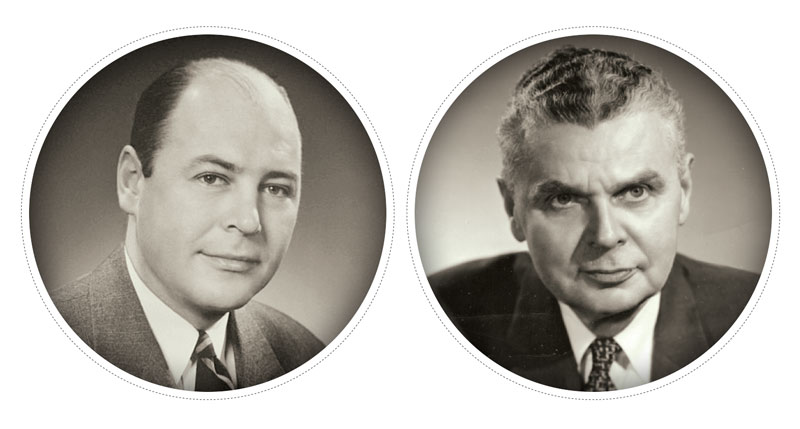
Queensway Health Centre; LM Archives
On March 25, 1958, the first Avro Arrow conducted a 35-minute test flight, followed nine days later by the fighter breaking the sound barrier. This proved the plane was one of the world’s most advanced military aircraft. Yet, even as the Arrow found its wings, it was doomed.
On March 31, 1958, Conservative Prime Minister John Diefenbaker turned a minority government into a majority in a snap election just 10 months after he had broken 22 years of Liberal rule. The Arrow program was a key Liberal initiative and the company’s president Crawford Gordon Jr. had close ties to the party.
Pounding on Diefenbaker’s desk, he demanded the Arrow be saved.
Gordon had previously been recruited by Minister of Munitions and Supply C.D. Howe as a “dollar-a-year man”—one of many Canadian titans of industry enlisted to work cheaply for the government during the Second World War—tasked with harnessing Canada’s industrial might for the war. Postwar, Howe picked Gordon to head the Department of Defence Production, which eventually led to overseeing the Arrow’s development.
Under Gordon, the fighter developed stunningly fast—28 months from initial drawings to rollout on Oct. 4, 1957. The achievement was outshone, however, by the Soviet Union’s launch of Sputnik 1, the first space satellite, the same day. Plus, less than two months earlier, the Soviets had launched the first intercontinental ballistic missile. Those feats soon led Britain to declare interceptor aircraft such as the Arrow obsolete. Meanwhile, Ottawa was questioning the project’s runaway costs.
“We are convinced that when the review takes place the Arrow will be ordered into production.”
—Crawford Gordon Jr.
In September 1958, Diefenbaker’s government announced the Arrow program would be reviewed the following spring. A furious Gordon met Diefenbaker for the first and only time on Sept. 17. A heavy drinker and chain-smoker, Gordon stormed into the room. As one government aide reported, Gordon was “incoherent, like a person demented.” Pounding on Diefenbaker’s desk, he demanded the Arrow be saved. The PM dismissed him outright.
Gordon, however, refused to give up, appearing shortly afterward on CBC. “I want to stress emphatically that the Arrow program has not been cancelled…On the contrary, the prime minister’s statement says the program is to continue…we are convinced that when the review takes place next March the Arrow will be ordered into production.”
The hammer fell earlier than expected, on Feb. 20, 1959, when Diefenbaker declared the Arrow’s termination in the House of Commons. Gordon’s response was immediate. He announced over the factory loudspeaker: “Notice of Termination. There will be no work for you.” On Black Friday, 14,000 employees were terminated and Canada’s aviation industry was dev-astated.
Gordon never recovered. On Jan. 26, 1967, he died in New York City from liver failure.
When John Diefenbaker’s Conservatives swept to a majority in March 1958, the Avro Arrow’s cancellation seemed inevitable. Its $1.1-billion price tag appalled the prime minister. And since the Arrow had been a pet Liberal project, Diefenbaker was also intensely suspicious of the Liberal-aligned executives at Avro—particularly its president Crawford Gordon Jr.
An eloquent orator, Diefenbaker presented himself as a spokesman for common Canadians abandoned by the Liberal establishment. The self-styled “man from Prince Albert” was determined to cut government spending, while simultaneously expanding national development—particularly in the North.
The Arrow, meanwhile, was losing support within the Canadian military. With attention swinging toward the perceived need for weapons to counter Soviet missile development, Diefenbaker’s defence minister, retired major-general George Pearkes, and Chiefs of Staff Committee chair General Charles Foulkes recommended abandoning the Arrow in favour of new American-built, nuclear-warhead capable Bomarc IM-99 surface-to-air missiles.
When Diefenbaker announced the Arrow review in September 1958, Avro launched an extensive publicity campaign advocating for the project’s continuation. This move “shocked” Diefenbaker. “If,” he said, “the government decided to continue development, it would be accused of giving in to a powerful lobby.”
Increasingly, Diefenbaker also argued the Arrow was obsolete. “There is no purpose in manufacturing horse collars when horses no longer exist,” Diefenbaker said after the British military declared the era of Arrow-like interceptor aircraft over.
The Arrow, meanwhile, was losing support within the Canadian military.
Diefenbaker declared the Arrow terminated in the House of Commons on Feb. 20, 1959. Abandoning the jet dogged his government, however. Many Canadians felt the project’s demise dealt a near-mortal blow to part of the national dream and reflected a lack of courage and vision in developing a national defence policy.
In the June 1962 election, the Arrow’s cancellation contributed to the Conservatives being reduced to a minority. Seeking to reverse his failing fortune, Diefenbaker called a snap election on April 8, 1963. His Conservatives bowed to a Liberal majority.
“There is no purpose in manufacturing horse collars when horses no longer exist.”
—Prime Minister John Diefenbaker
Beforehand, on Jan. 25, 1963, Diefenbaker defended the Arrow’s cancellation in the House. “Some people talk about courage. Well, we took a stand in reference to the Arrow. No one wanted to take that stand. As I look back on it, I think it was one of the decisions that was right. Here was an instrument, beautiful in appearance, powerful, a tribute to Canadian production…this instrument that…would have contributed little, in the changing order of things, to our national defence.”
Advertisement






















